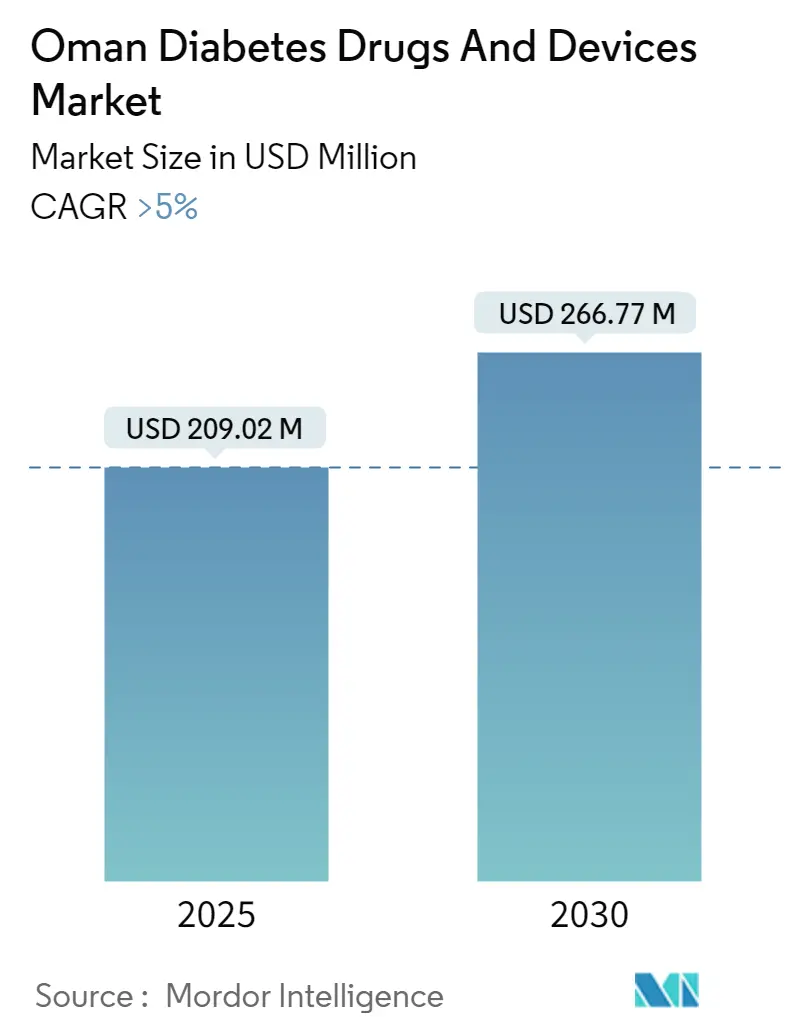
| Study Period | 2019 - 2030 |
| Base Year For Estimation | 2024 |
| Forecast Data Period | 2025 - 2030 |
| Historical Data Period | 2019 - 2023 |
| Market Size (2025) | USD 209.02 Million |
| Market Size (2030) | USD 266.77 Million |
| CAGR (2025 - 2030) | 5.00 % |
Major Players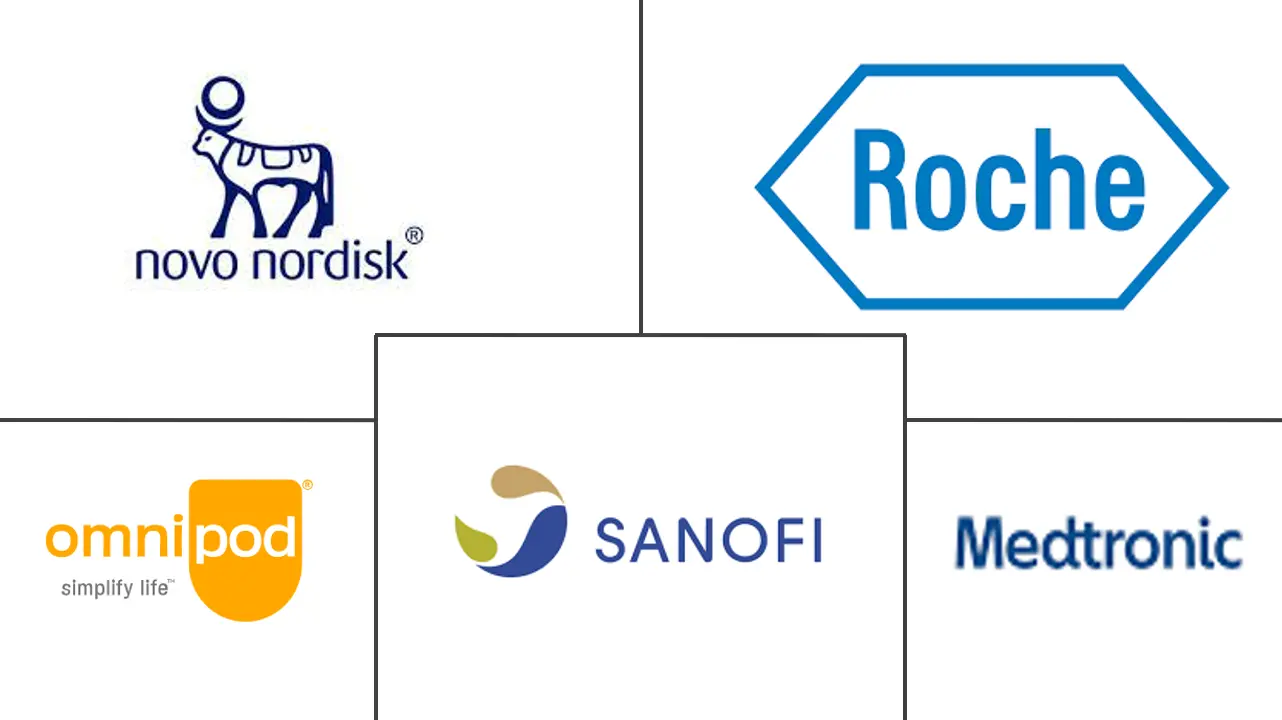
*Disclaimer: Major Players sorted in no particular order |
Oman Diabetes Drugs and Devices Market Analysis
The Oman Diabetes Drugs And Devices Market size is estimated at USD 209.02 million in 2025, and is expected to reach USD 266.77 million by 2030, at a CAGR of greater than 5% during the forecast period (2025-2030).
The COVID-19 pandemic has positively impacted the Oman diabetes care equipment market growth. Diabetics infected with SARS-CoV-2 experience additional stress and increased secretion of hyperglycemic hormones, leading to elevated blood sugar levels, abnormal blood sugar fluctuations, and diabetic complications. Diabetes and uncontrolled hyperglycemia are risk factors for poor prognosis in COVID-19 patients, including increased risk of serious illness and death. To avoid complications, the patient's blood glucose level must be normal. Diabetic device makers are scrambling to ship devices to diabetics with the help of local governments during the COVID-19 crisis. The pandemic emergency has increased telemedicine by both patients and healthcare workers, removing many long-standing regulatory barriers.
Diabetes is associated with many health complications. People with diabetes need to make multiple corrections throughout the day to maintain nominal blood sugar levels, such as administering additional insulin or monitoring blood sugar levels and ingesting other carbohydrates.
Diabetes is a growing health burden nationwide and is a leading cause of premature death, morbidity, and loss of economic growth. Oman's Ministry of Health recently attended the virtual launch of the WHO Global Diabetes Compact, co-hosted by the World Health Organization and the Government of Canada. The compact aims to raise awareness of diabetes as a global disease and expand prevention and treatment as part of primary health care. Care and general health care.
Diabetes is an expensive chronic disease that requires medical devices to monitor blood sugar levels, according to the Oman Diabetes Association. This poses a challenge for low-income and social security patients, and efforts are being made to reduce the burden on these patients and promote carbohydrate restriction.
As part of an ODA initiative, Oman is trying to educate people with diabetes on the use of blood glucose meters. In addition, there are about 60 new pediatric infections per year. According to local studies and reports of reasonable diabetes control, the rate is 32-35% in adult patients but reaches 10-12% in children and adolescents. Governments are working to raise awareness of diabetes and increase access to blood glucose meters to improve diabetes management in children.
Based on the abovementioned factors, the market under study is expected to grow during the analysis period.
Oman Diabetes Drugs and Devices Market Trends
The continuous Glucose Monitoring Segment is Expected to Witness the Highest Growth Rate Over the Forecast Period
In CGM, a small sensor is inserted into the abdomen or arm, and a small plastic tube called a cannula is inserted into the top layer of skin. An adhesive patch holds the sensor in place, allowing it to measure glucose levels in interstitial fluid day and night. In general, the sensor should be replaced every 7-14 days. A small, reusable transmitter attached to the sensor allows the system to wirelessly transmit real-time readings to a monitor displaying blood glucose data. Some systems have their monitors, while others display information via smartphone apps.
The frequency of monitoring blood glucose levels depends on the type of diabetes and is different for each patient. People with type 1 diabetes should have their blood sugar checked regularly, monitor their blood sugar levels, and adjust their insulin dosage accordingly. His CGM device now details blood glucose patterns and trends compared to routine blood glucose monitoring at set intervals. In addition, current continuous blood glucose monitors can retroactively check blood glucose trends by downloading data or providing real-time images of blood glucose levels via the receiver display.
Continuous glucose monitoring sensors use glucose oxidase to measure blood sugar levels. Glucose oxidase converts glucose to hydrogen peroxidase, which reacts with platinum in the sensor to send an electrical signal to a transmitter. The sensor is the most important part of any continuous blood glucose monitoring device. Technological advances in improving sensor accuracy are expected to drive the growth of the segment during the forecast period.
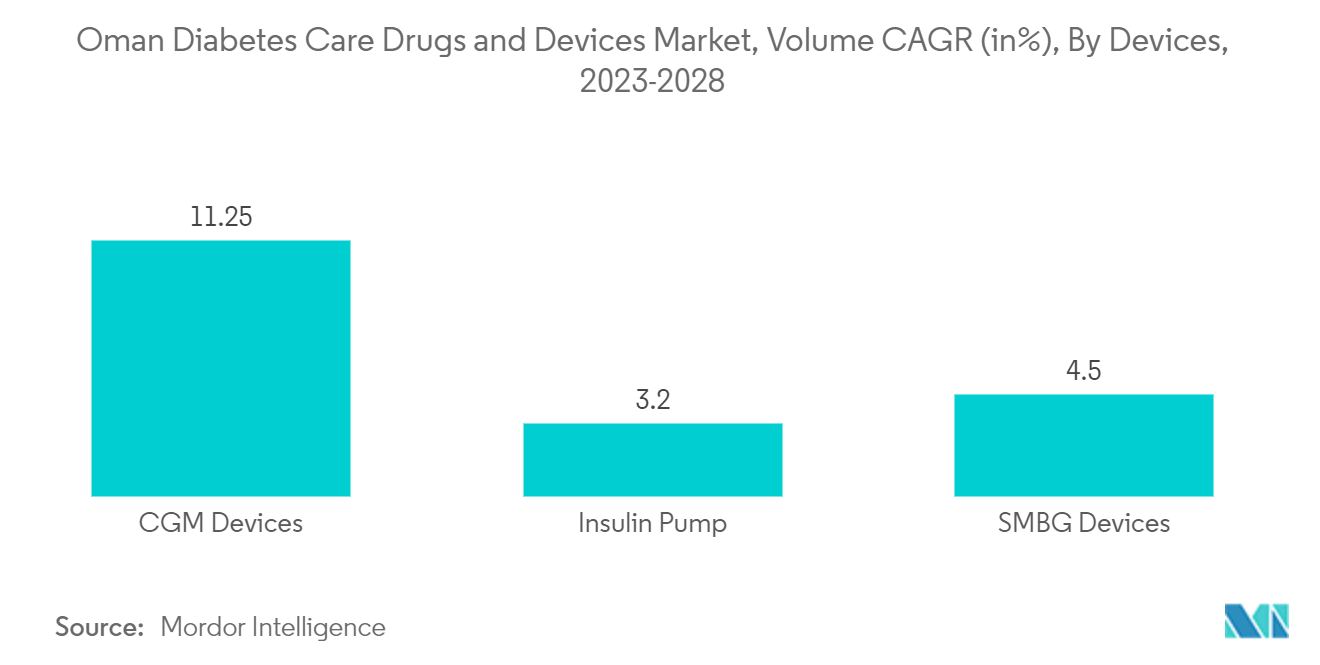
Rising diabetes prevalence in Oman driving the market in the forecast year
According to the Oman Diabetes Association, diabetes is an expensive chronic disease requiring blood sugar level control. This poses a challenge for low-income and social security patients, and efforts are being made to reduce the burden on these patients and promote carbohydrate restriction. In addition, there are about 60 new pediatric infections per year. According to local studies and reports of good diabetes control, the rate is 32-35% in adult patients but reaches 10-12% in children and adolescents. Governments are committed to raising awareness of diabetes and increasing access to medicines to improve diabetes management.
Diabetes shortens life, and people with the disease are more likely to go blind and be hospitalized for amputations, kidney failure, heart attack, stroke, and heart failure. Metformin is the first-line treatment for hyperglycemia in T2DM. Metformin is not only an essential hypoglycemic agent but also has important anti-inflammatory properties. Other options should be considered if metformin is contraindicated or not tolerated or if treatment goals are not achieved after three months of maximum tolerated dose. Dipeptidyl peptidase four inhibitors, sodium glucose cotransporter two inhibitors, and glucagon-like peptide one agonist are commonly used as adjuncts to metformin treatment.
The Ministry of Health, Oman is strategically planning to contain the growing burden of diabetes and invest in all means to control it, stating that their work needs to ensure equitable and affordable access to treatment, and it is essential that they advocate for investments in diabetes education and prevention programs in Oman. Risk factors such as insufficient physical activity and the consumption of unhealthy diets are contributing to the development and progression of the disease.
The increasing diabetes prevalence and the above factors will likely drive segment growth over the forecast period.
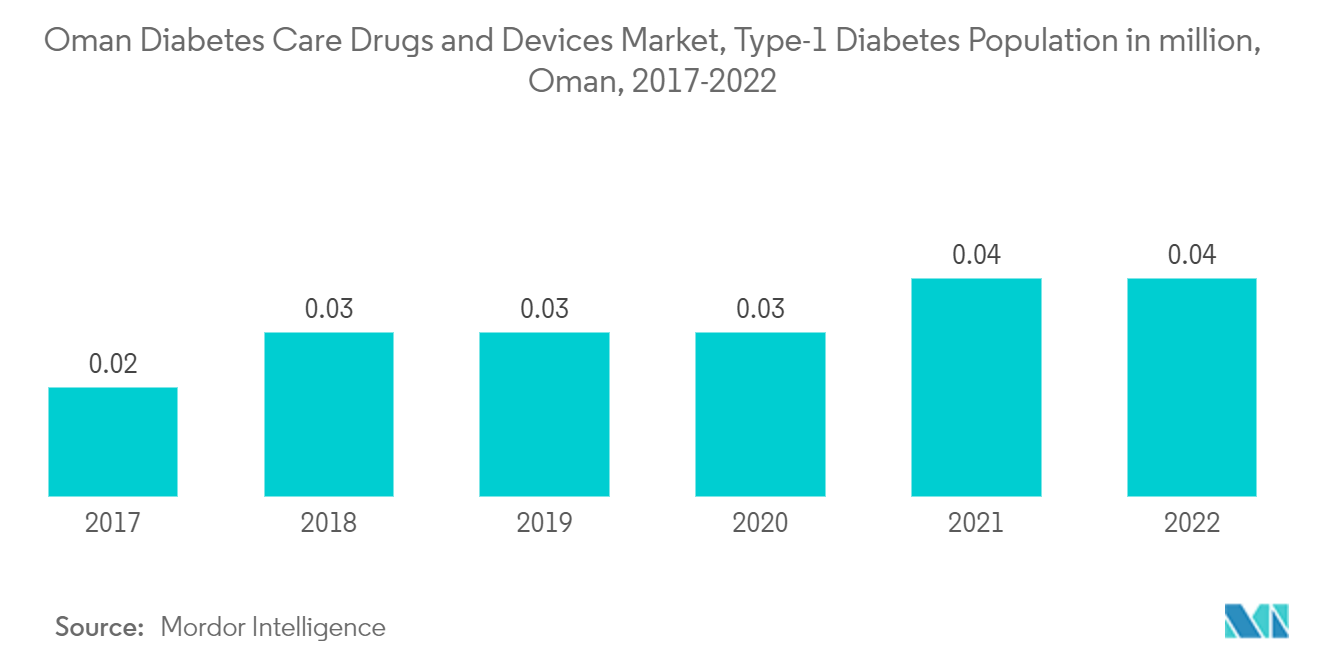
Oman Diabetes Drugs and Devices Industry Overview
In order to survive in the market, manufacturers have constantly innovated. Large companies like Abbott and Medtronic have made numerous mergers, acquisitions and partnerships to gain market dominance while adhering to organic growth strategies. Manufacturers of insulin dosing devices spend a lot of money on R&D of the drugs and devices.
Oman Diabetes Drugs and Devices Market Leaders
-
Medtronics
-
Roche
-
NovoNordisk
-
Sanofi
-
Omnipod
- *Disclaimer: Major Players sorted in no particular order
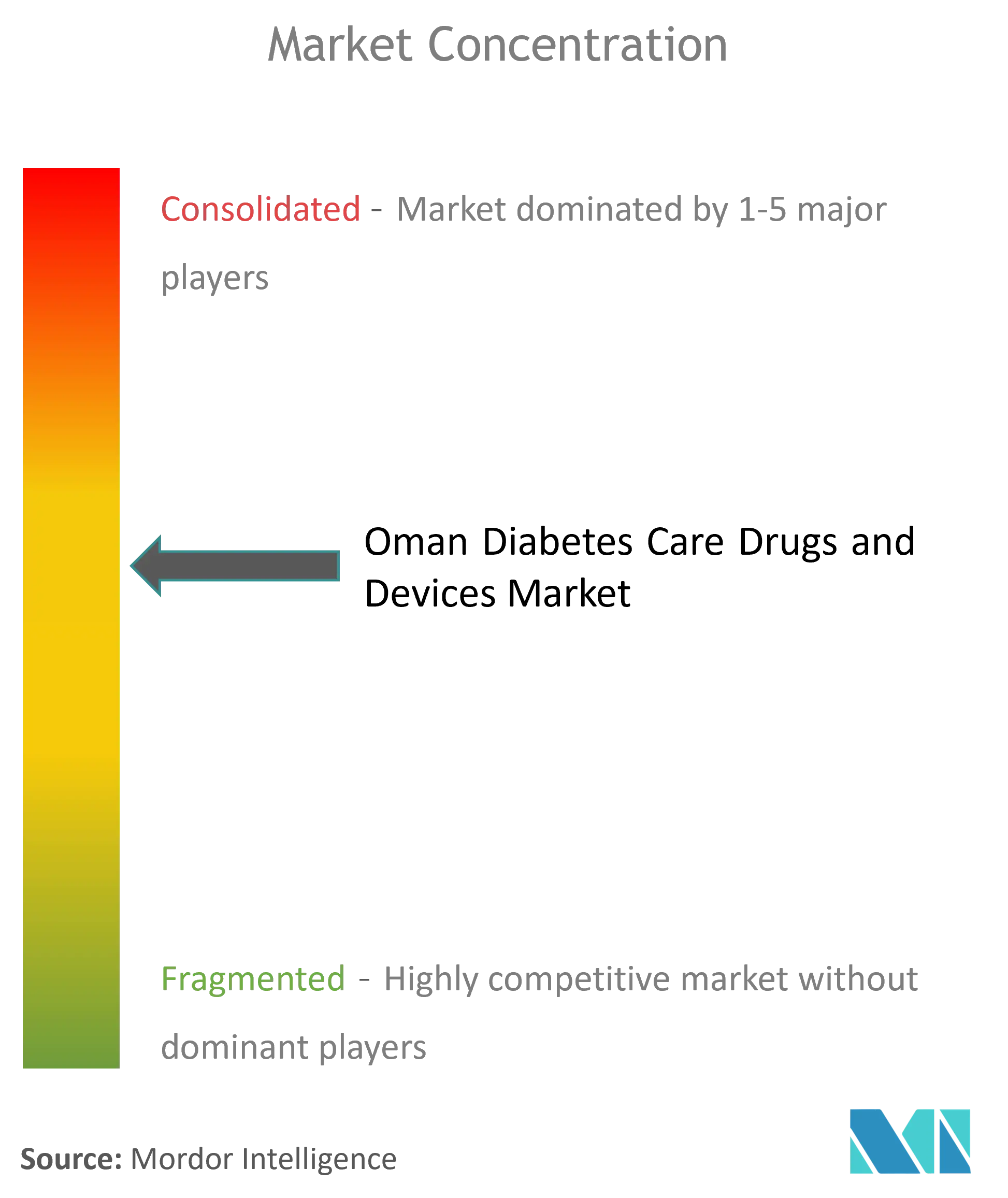
Oman Diabetes Drugs and Devices Market News
- April 2023: The Ministry of Health Research Centre in Oman has undertaken research to explore various models that aim to enhance the accuracy of T2DM diagnoses for Omani Prediabetes Patients. These models utilize Artificial Neural Networks and Six Machine Learning Classifiers.
- October 2022: The Ministry of Industry and Advanced Technology announced the signing of a pair of memoranda of understanding worth AED 260 million (USD 70.8 million) between major pharmaceutical and medical device companies in the UAE. The partnerships align with the National Strategy for Industry and Advanced Technology and the ICV Program. It aims to attract investors and manufacturers to the UAE's pharmaceutical and medical equipment sectors. Under a separate MoU, PureHealth, and Gulf Pharmaceutical Industries Company will establish the first factory in the Middle East to produce Glargine to treat diabetes.
Oman Diabetes Drugs and Devices Industry Segmentation
A blood glucose meter (BGM) measures the blood glucose level at the measurement time. To use the meter, a small amount of blood is dripped onto the test strip by inserting the test strip and pricking a finger with a lancing device to obtain a blood sample. The meter displays blood glucose levels in mg/dl (US standard) or mmol/l (European standard). Oman diabetes drugs and devices market is segmented by drugs (insulin, oral anti-diabetic drugs, non-insulin injectable drugs, and combination drugs), and devices (management devices (insulin pumps, insulin pens, syringes, cartridges, and jet injectors) and monitoring devices (self-monitoring blood and continuous glucose monitoring)). The report offers the value (in USD) and volume (in unit) for the above segments.
| Devices | Monitoring Devices | Self-monitoring Blood Glucose Devices | |
| Continuous Blood Glucose Monitoring | |||
| Management Devices | Insulin Pump | ||
| Insulin Syringes | |||
| Insulin Cartridges | |||
| Disposable Pens | |||
| Drugs | Oral Anti-Diabetes Drugs | ||
| Insulin Drugs | |||
| Combination Drugs | |||
| Non-Insulin Injectable Drugs | |||
Oman Diabetes Drugs and Devices Market Research Faqs
How big is the Oman Diabetes Drugs And Devices Market?
The Oman Diabetes Drugs And Devices Market size is expected to reach USD 209.02 million in 2025 and grow at a CAGR of greater than 5% to reach USD 266.77 million by 2030.
What is the current Oman Diabetes Drugs And Devices Market size?
In 2025, the Oman Diabetes Drugs And Devices Market size is expected to reach USD 209.02 million.
Who are the key players in Oman Diabetes Drugs And Devices Market?
Medtronics, Roche, NovoNordisk, Sanofi and Omnipod are the major companies operating in the Oman Diabetes Drugs And Devices Market.
What years does this Oman Diabetes Drugs And Devices Market cover, and what was the market size in 2024?
In 2024, the Oman Diabetes Drugs And Devices Market size was estimated at USD 198.57 million. The report covers the Oman Diabetes Drugs And Devices Market historical market size for years: 2019, 2020, 2021, 2022, 2023 and 2024. The report also forecasts the Oman Diabetes Drugs And Devices Market size for years: 2025, 2026, 2027, 2028, 2029 and 2030.
Our Best Selling Reports
Oman Diabetes Drugs and Devices Industry Report
Statistics for the 2025 Oman Diabetes Drugs And Devices market share, size and revenue growth rate, created by Mordor Intelligence™ Industry Reports. Oman Diabetes Drugs And Devices analysis includes a market forecast outlook for 2025 to 2030 and historical overview. Get a sample of this industry analysis as a free report PDF download.




